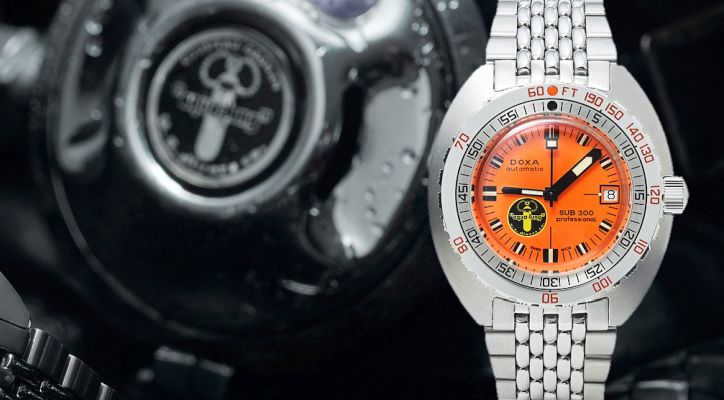
In 2017, Doxa has released several “anniversary” timekeepers that celebrate the brand’s first semicentennial in the business of making professional diving tools. While the blackfaced Sharkhunter and the silver-faced Searambler attracted their fair share of attention from collectors and, um, more normal enthusiasts alike, it was the Sub 300 “Black Lung” Limited-Edition automatic diver that broke the brand’s own sales record with the whole bunch being pre-ordered during the first 24 hours after registration officially commenced.
Overall Impression
Throughout its not particularly long history, Doxa used to experiment with different styles and different niches. Even during the last decade alone, there was a surprisingly inexpensive quartz-powered Splash and Grafic Mistero models designed to compete with “entry-premium” Japanese chronographs, and there also was a deliberately vintage-styled dressy Chateau des Monts 120th Anniversary powered by a hand-wound Unitas pocket watch caliber.
Still, it looks like recently the brand’s management finally decided to concentrate all efforts on keeping the niche where Doxa S.A. is at its strongest: the divers.
If you take just a minute or two to explore their website, you will see that most -if not all- of their currently available collections are either reissues of or homages to their historic models. Using the same signature tonneau-shaped, deliberately oversized cases and what they like to call the “iconic” dwarf hour hand design (in two words: the minutes hand is significantly larger than the hours hand accenting the timekeepers’ primary function of a dive timer,) they manage to give their wristwatches that distinctive appearance that many customers -especially those who already have a Rolex Sub and/or an Omega Seamaster in their winders- look for while shopping for a new premium-priced diving companion that looks “different”.
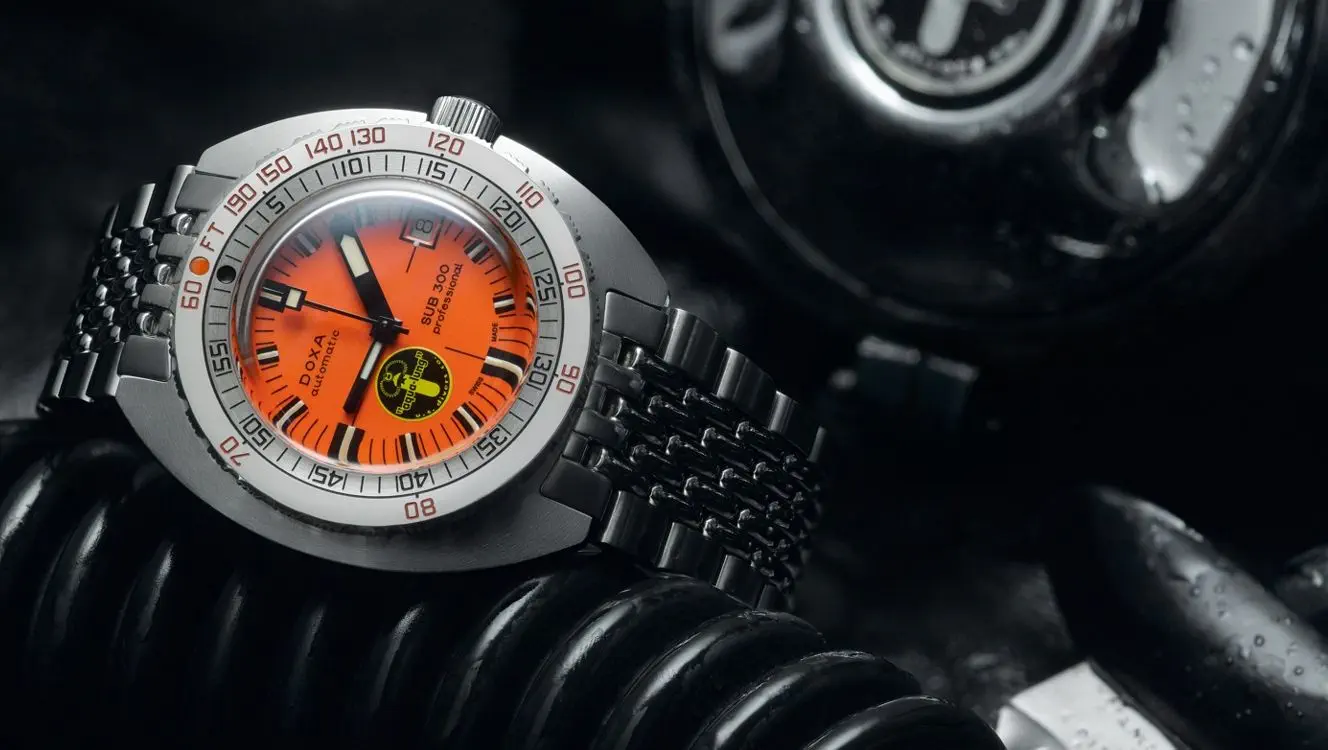
Yes, with current public demand for all things vintage, it would be stupid not to ride the wave when you have something special to offer and the Swiss brand does that in style. Their new DOX Sub 300 “Black Lung”, for example, is offered as a re-issue of a watch that was originally sold back in 1967 together with US Divers: an American subsidiary of the legendary French-based maker of diving equipment that was later renamed as Aqua Lung America.
Known among enthusiasts as the “Black Lung,” the experimental model was manufactured at a low volume (I am not even sure if it ever graduated past the prototype status) and introduced that classic exterior design that Doxa divers are mostly associated with these days.
Case, Bezel & Strap
This anniversary edition model reproduces the exterior of the original faithfully, although some things look different (and I am not sure whether I like -or at least okay with- the way the watchmaking specialist decided to pinch pennies on the minor elements described below.)
Comparing the “Black Lung” to several images of the historic gadget that I was able to find on the internet, I see that the signature multi-link “beads of rice” bracelet is now more refined, although the trademark tapering that gradually decreases the bracelet’s width from 24 millimeters at the lugs to 22 millimeters at the clasp (the clasp features a nice wetsuit extension) is still here.
The bracelet seems to be identical to the one used in their current “50th Anniversary Collection” line including the SUB 300 Professional -perhaps, the closest thing to that classic 1967 appearance and you should probably take a look at it if you missed on getting one of the “Black Lungs” reviewed here-, the dark Sharkhunter, and the breathtaking Searambler.
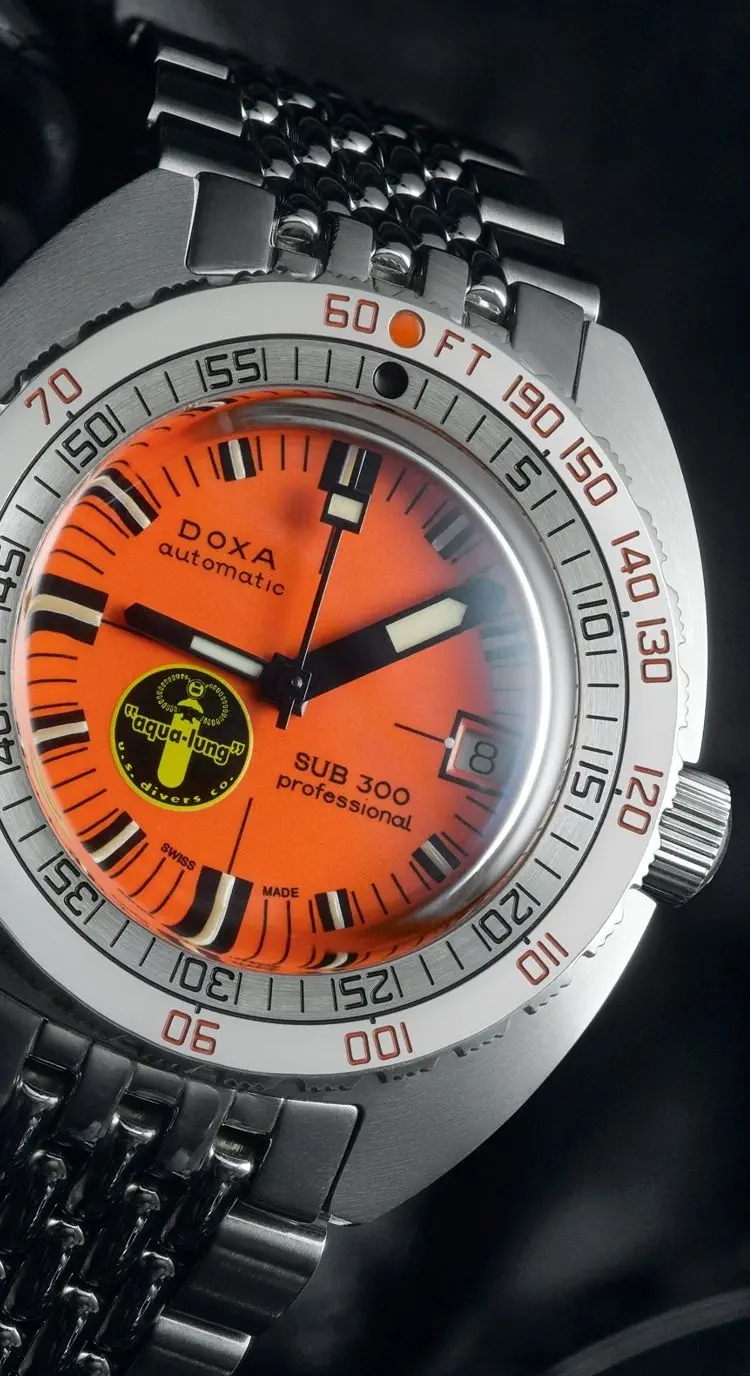
The two-part unidirectional rotating bezel, too, is slightly different. The signature “US Navy maximum no decompression limit times” scale is still here, yet the “feet” markings are not the same starting at “190” and going to “60 FT” instead of the more traditional 195 feet to 65: again, it looks like Doxa decided to cut a corner here and re-used bezels that come with their modern pieces (like, for example, this SUB 600T-Graph diver, although the original silvery gray dot of Superluminova was replaced with a more historically correct black one.)
Even if it doesn’t look like a big deal -and something tells me that the three hundred lucky guys who bought all individually numbered pieces within the first 24 hours weren’t particularly disappointed either-, this is why I prefer to call it an “homage to” rather than a “re-issue of” the original model.
During the last decade, we became so accustomed to oversized divers that a watch of more than 45 millimeters in diameter and over 16 millimeters thick is often considered a de facto standard for a diving timekeeper rated from 30 ATM and above. In this respect, the Sub 300 “Black Lung” looks like a breath of fresh air if you pardon me using the cliche.
Like the original (or at least close to it,) the gadget measures just 42.50 millimeters wide and is only 13.40 millimeters thick (the case itself is just 12.40 mm from top to bottom with an extra millimeter added by the sapphire “bubble”) making it not only relatively light but also more convenient to wear with casual clothing. Machined from the same block of steel as the rest of the body, the integrated lugs are, too, relatively short not adding much to the overall length of the case: even persons with narrow wrists will probably find the watch fitting.
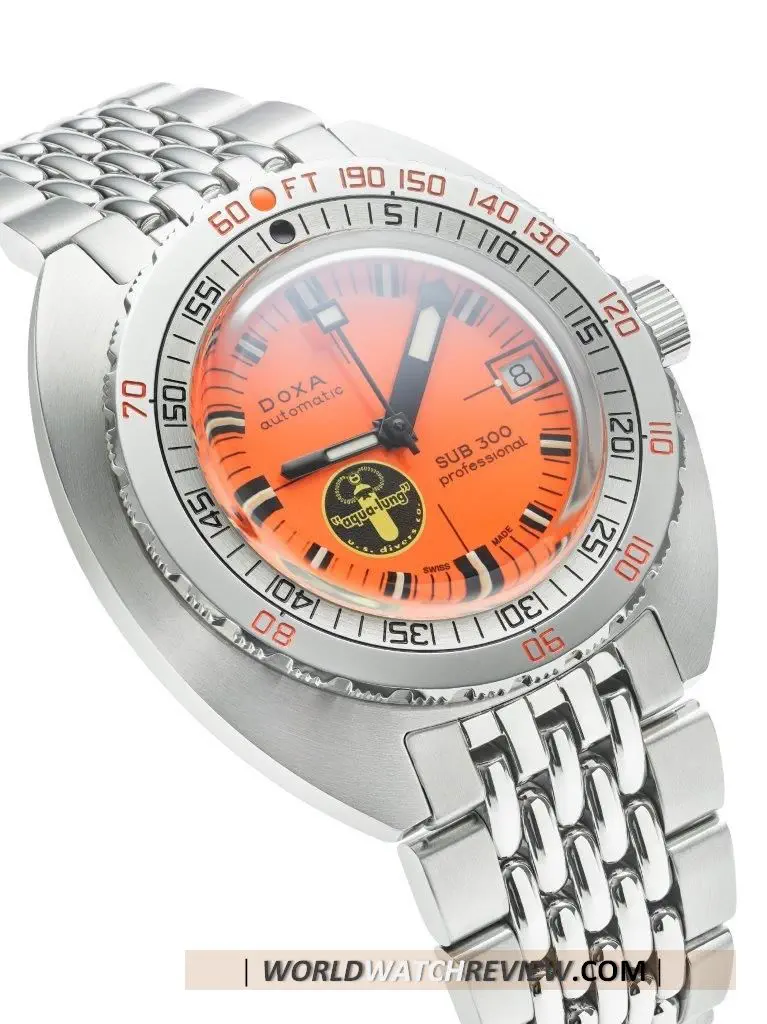
The setting/winding crown is on a smaller size but offers a good grip. The only problem that I see here is that protruding from the side of the case by some 1/10th of an inch, the crown isn’t adequately protected from an accidental bump, although, being a screw-down one, it probably won’t transfer the shock to the movement itself, which is a relief.
Mechanism
I wasn’t able to find information regarding the 1967 model’s mechanical guts. Its closest relative -a 1967 Vintage DOXA SS SUB 300T Searambler– appeared to be powered by caliber ETA 2472 and that makes me fairly confident that the original Sub 300 “Black Lung” was animated by the same movement: after all, when you have a stash of ready to case calibers and a team of workers trained to handle them efficiently, why would you experiment with other movements? I mean, those were the 1960s: people buying mass-produced luxury watches weren’t as obsessed wondering what kind of Swiss-made mechanism defines them as persons, were they?
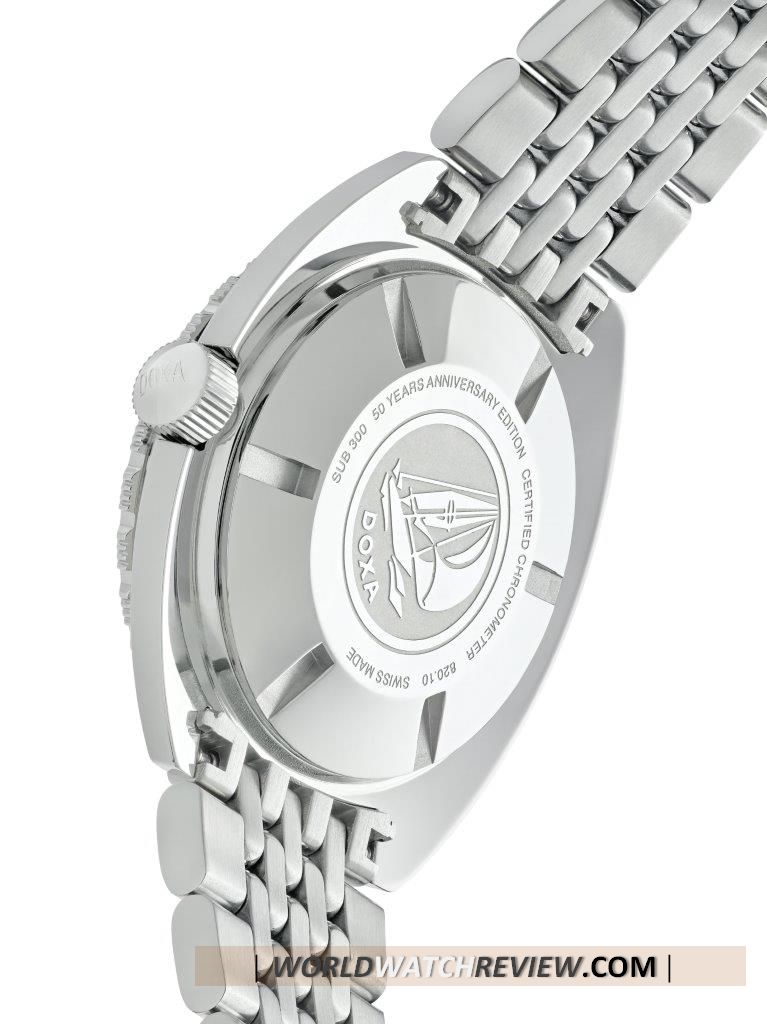
These days the ETA 2472 calibers are in short supply while serious independent brands still have plenty of perfectly good ETA 2824-2 movements lying in their storage facilities just waiting to be re-finished, oiled, cased, and sold at a nice premium.
Some of them, like the one DOXA decided to use here, even have a stock of COSC-certified chronometer-grade versions of the calibers that are a perfect choice for this particular homage: with the mechanism featuring the same casing diameter as the older engine, the new stainless steel case fits the caliber like the proverbial glove. What’s even more important, it allowed the Swiss watchmaker to leave the proportions of the dial virtually intact (see below.)
WorldWatchReview.com may not be as old as Doxa, but next April 2018 this blog will celebrate its first decade in business and I must admit that, after all these years spent praising the industry workhorse’s outstanding dependability, bullet-proof reliability, and impressive accuracy, the routine starts to feel old. So, I’ll just summarize it: if you are looking for a luxury mechanical timekeeper that is powered by a self-winding movement and you can’t afford a Rolex, a watch powered by an ETA 2824-2 -especially if it is manufactured by a reputable brand that doesn’t cut corners when it comes to quality control and is willing to invest some cash to properly adjust it before shipment- is the next best thing here.
Doxa has a reputation as just such a brand: their wristwatches are usually accurate right out of the box and don’t need to be taken to a service person right away just to get them more or less usable (which is often the case with self-winding watches in the sub-$700 category,) so in this respect, you are all set.
Dial & Legibility
The most prominent thing about the Sub 300’s dial -besides the “Black Lung” logo that is placed at its historic place between 7 and 8 o’clock- is the iconic “dwarf” hour hand: a design that the Swiss brand has been using for the last fifty years or so.
For a normal timepiece, the design where the hour hand is significantly smaller than the minute pointer would be a major blow in terms of overall readability and common logic. However, if you take a moment to consider that this is primarily a diving watch, you may come to the same conclusion as yours truly: the relative proportions of the hands do a pretty good job at -here comes a bit of a surprise for some persons- telling dive time!
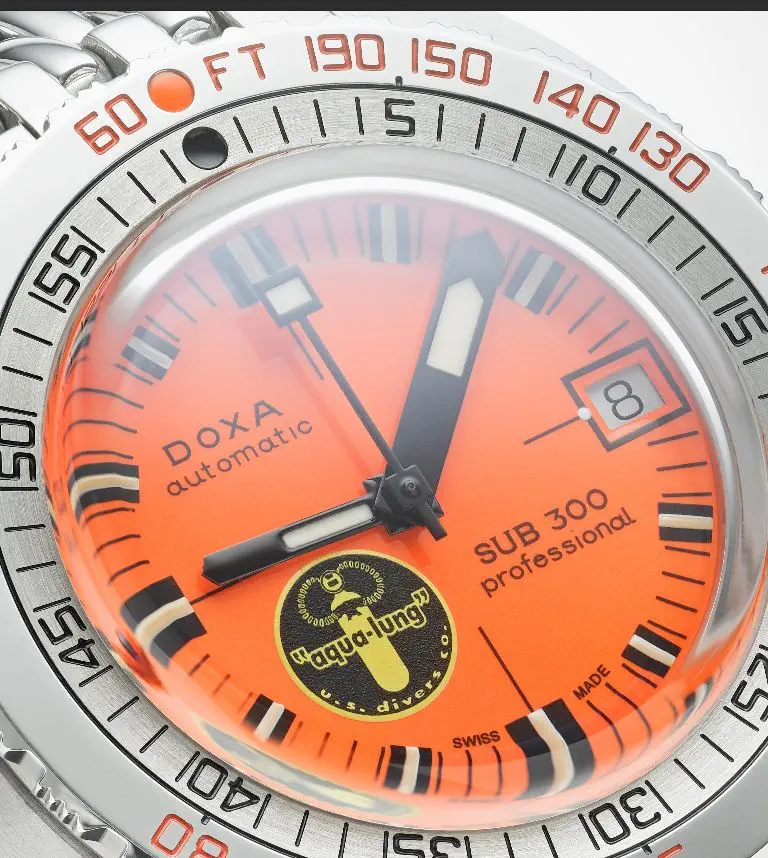
Consider this: while you are deep underwater studying some coral reef or exploring a Nazi battleship sunk by an Allied submarine more than seventy years ago somewhere in the Atlantic ocean, what’s more important to you? The time before supper or, perhaps, an approximate amount of air left in your scuba tanks?
Luxury divers are rarely bought for real diving these days. Like with luxury guitars and other gear designed with wealthy hobbyists in mind, only a fraction of professionals can afford one to use as a tool: after all, there is a wide choice of electronic diving computers out there that are, first, a lot more affordable and, second, a great deal more dependable and versatile than an archaic mechanical timekeeper. In this respect, overall legibility is a lot more important and here the “Black Lung” is good, too, earning respectable four and a half stars out of five in this department.
Where is the other half a star you may ask? Well, besides the “dwarf” hour hand that will confuse a normal user with its wrong proportions, there is a cluttered chapter ring that gives the dial a busier look than one might have expected from a “diver,” and there is also the date window that is too small: the usual problem with “standard” ETA-powered three-handers.
You may also be not particularly happy with the way its “double bubble” sapphire crystal (yep, they decided to replace the original “Plexi” organic glass with a more “luxurious” material for this watch) distorts the dial at certain angles, but, when buying a professional-grade diver that is designed to withstand great pressure, that comes with the territory and should be considered as a feature, not a bug.
Pricing & Availability
When DOXA’s PR department first disseminated a news release regarding their then-upcoming re-issue, they offered an attractive price of just $2590 for those lucky three hundred persons who were willing to pre-order the limited-edition version. That was good news. The bad news, however, was that the Sub 300 “Black Lung” was sold out faster (figuratively speaking) than an iPhone X: it took Doxaless than 24 hours to make $777,000 almost out of thin air. Just like that.
It’s hard to predict how their resale price will behave after the first initial spike of interest from enthusiasts gradually wears out: I still think that the limited edition is overpriced for what it has to offer, but I do envy the guys who managed to lay their hands on one of these orange-faced beauties.
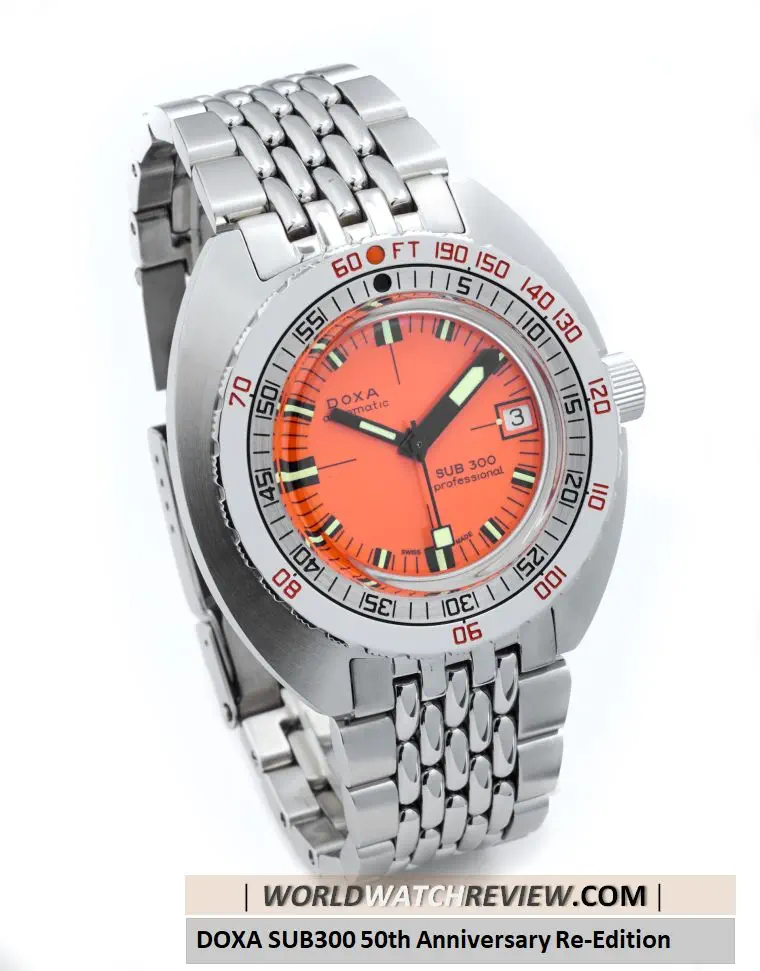
WWR verdict
Originality 5/5
Build quality: 5/5
Usability: 4.5/5
Overall Legibility: 4.5/5
Nighttime Legibility: 4.5/5
Value for money: 3.5/5
Overall Rating: 4.5/5
See also: DOXA SUB 5000T Seaconqueror diving companion
Photos: Doxa Watches
DOXA Sub 300 “Black Lung” specification
Price: $2590 (special pre-order price)
Winding: Automatic
Movement: Caliber ETA 2824-2, COSC-certified chronometer, Incabloc shock protection system and hacking seconds, Swiss Made
Number of jewels: 25
Power reserve: 40 hours
Cadence of balance: 28,800 vph
Functions: Hours, minutes, seconds, date
Case: Stainless steel, brushed
Shape: Tonneau
Bezel shape: Round
Size: 42.50 mm
Case height: 13.40 mm
Lug width: 24.00 mm
Dial: Orange with black accents
Hour markers: Luminous, applied
Hands: Luminous, black
Water resistance: 300 meters
Strap: Multilink “bead of rice” stainless steel bracelet; tapers from 24 to 22 millimeters; wetsuit extension
Crystal: Sapphire, antireflective, historic “double bubble” profile
Back: Solid, engraved with “xxx/300” limited edition number, screw-down
